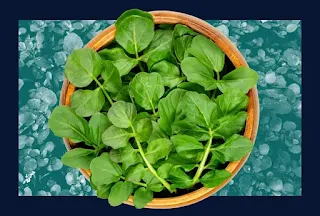It's also incredibly easy to prepare.Among the many vegetables available to us, one stands out
as particularly beneficial:
Watercress:
According to the Centers for Disease Control and Prevention (CDC), this leafy green has earned the title of the healthiest vegetable, boasting a perfect nutrient density score of 100 out of 100. It even outperformed Chinese cabbage, which ranked second, by more than eight points.Nutrition experts aren’t surprised by this.
“I can believe that watercress is the healthiest vegetable,” says Dana Ellis Hunnes, Ph.D., a senior dietitian at UCLA Medical Center. She highlights watercress as a “nutrient-dense” food, offering a high concentration of nutrients for the calories it provides.
What is Watercress and Why is it So Healthy?Watercress is part of the cruciferous vegetable family, related to kale, broccoli, arugula, and Brussels sprouts. It’s also an aquatic plant that thrives in shallow water or moist soil. Its nutrient density score, which rates foods based on their nutritional value per calorie, is a testament to its health benefits. The higher a food’s nutrient density, the more vitamins, minerals, and antioxidants it offers.
Watercress contains compounds like 3,3′-diindolylmethane (DIM) and sulforaphane, both linked to a reduced risk of cancer. Additionally, it's a rich source of vitamin K. However, while watercress provides fiber, it doesn't contain as much as other cruciferous vegetables.
For example, one cup of broccoli provides around 5 grams of fiber, while a cup of watercress has less than 1 gram. So, it’s important to eat a variety of vegetables to meet your fiber needs.
How Does Watercress Compare to Other Vegetables?
While watercress scored a perfect 100 in the CDC study, other vegetables also ranked highly, including:
Chinese cabbage (91.99 points)
Swiss chard (89.27 points)
Beetroot (87.08 points)
Spinach (86.43 points)
How Much Watercress Should You Eat?
It’s recommended to consume four to five servings of fruits and vegetables daily, with cruciferous vegetables making up a portion of that. While you can eat watercress as often as you like, a good guideline is to aim for one cup per serving. You can enjoy it raw for maximum nutrients, as cooking can reduce the levels of heat-sensitive vitamins like vitamin C and B vitamins.Use watercress in salads, sandwiches, or even as a topping for stir fries.
However, it’s important to remember that while watercress may be the healthiest vegetable, a diverse diet rich in various fruits and vegetables is still the best approach to ensure you get a full range of nutrients.
#DanaEllisHunnes #krikya.io #KorinMiller #sep122024 #Food&#Wine #Nutrition

Comments
Post a Comment